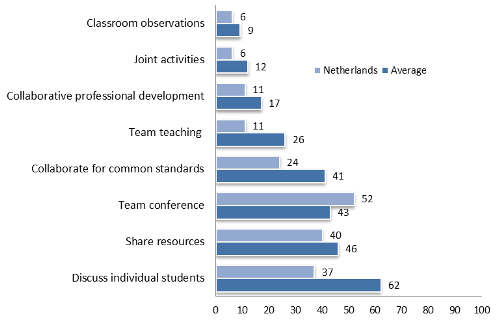by Montserrat Gomendio
Deputy Director, Directorate for Education and Skills
 |
|
Activities undertaken by lower secondary teachers at least once per month,
OECD Teaching and Learning International Survey (TALIS) 2013 |
A new OECD review of the Netherlands education system offers a roadmap towards excellence. Netherlands 2016: Foundations for the Future, based on data from both PISA and the Survey of Adult Skills, confirms that the country already enjoys a high-quality and highly equitable education system. But it also identifies areas that need to be improved as the country moves its education system, in the words of Dutch Minister of Education, Culture and Science Jet Bussemaker, “from good to great”.
The Dutch school system is highly stratified, and uses early tracking extensively. For a long time the Netherlands has made this complex school system work well for students: students performed well at school, socio-economic status had a relatively weak impact on performance, and were readily employable when they completed their schooling (the number of young people who are neither employed nor in education or training is among the lowest across OECD countries). Our analysis shows large differences in performance within educational tracks, and a large degree of overlap in literacy and numeracy performance between tracks. This implies that students in different tracks are equipped with more similar levels of skills than is observed in other countries, probably due to the existence of “bridge classes” and “scaffolding diplomas” which allow for greater flexibility among the different curricula. But evidence points to a worrying trend towards making the system more rigid, which could lead to less movement between tracks and an erosion of the equity levels that the system enjoys today.
The complexity of these issues calls for a coherent policy response. Netherlands 2016, the first report of its kind since the late 1980s, proposes making student selection more objective by giving more prominence to an objective national test; limiting secondary schools’ autonomy in selecting students into different educational tracks; and making the system more permeable to ensure that students progress more smoothly through the education system. The latter calls for various measures, including the alignment of curricula of different tracks, more personalised teaching and learning, promoting larger secondary schools that offer all education tracks through financial incentives.
More efforts should also be made to attract talented and motivated people to the teaching profession especially since many teachers in the Netherlands are approaching retirement age. A more systematic approach to the professional development of teachers is needed. The OECD Teaching and Learning International Survey (TALIS) 2013 shows that collaborative working and learning among teachers is not well established in the Dutch school system, yet these practices have proven essential for improving the quality of teaching. These findings stand at odds with the country’s ambitions to develop its schools into learning organisations.
The system has achieved a good balance between a large degree of school autonomy and efficient accountability mechanisms. However, given the extent of school autonomy, more effort should be invested in training school principals.
The quality of early childhood education and care should also be improved. Although participation rates are high, most parents use childcare facilities fewer hours a week than parents in most other OECD countries do. A national curriculum framework, higher staff qualifications and more staff training are needed to ensure all early childhood education and care services are of high quality and deliver good outcomes for children, and long-term benefits for Dutch society as a whole.
Links:
Netherlands 2016: Foundations for the Future
Teaching and Learning International Survey (TALIS) country note for the Netherlands
Chart source: © OECD

